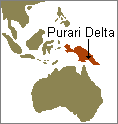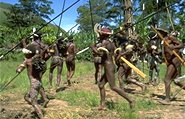Not all isolated, small-scale foraging or horticultural societies developed millenarian movements when they were put under great pressure to acculturate by militarily powerful outsiders. However, rapid destructive acculturation most often occurs. The dominant, controlling society in a culture contact situation rarely takes the time and effort to find out ahead what the impact of their technology and culture will be on the indigenous societies that they are dominating.
 |
|
The Purari Delta
![]() tribes of coastal Papua New Guinea
tribes of coastal Papua New Guinea
![]() provide an example of unintended effects in such culture contact situations. Prior
to their first encounter with Europeans, they lived as hunters, gatherers, and small-scale
farmers in the isolation of 500 square miles of densely vegetated delta land, rivers, and
swamps. The 8,000 Purari people were concentrated in 6 large
villages which had
institutionalized patterns of raiding each other to obtain victims for ritual
cannibalism. The large settlements provided personal defense and the social benefits
of a more exciting ceremonial life.
provide an example of unintended effects in such culture contact situations. Prior
to their first encounter with Europeans, they lived as hunters, gatherers, and small-scale
farmers in the isolation of 500 square miles of densely vegetated delta land, rivers, and
swamps. The 8,000 Purari people were concentrated in 6 large
villages which had
institutionalized patterns of raiding each other to obtain victims for ritual
cannibalism. The large settlements provided personal defense and the social benefits
of a more exciting ceremonial life.
 |
|
Papua New Guinea men |
|
The Purari tribes all shared
an elaborate religious belief system in which all adult males participated. To
become a participant, boys had to go through an initiation ceremony (pairama
![]() ) in
which they ate part of a dead enemy. By so doing, they acquired the power (imunu
) in
which they ate part of a dead enemy. By so doing, they acquired the power (imunu
![]() )
of the victim. Only males were cannibals and it was only done in connection with
this initiation ceremony. However, victims could be male, female, young, or
old. Without acquiring imunu, boys could not become men, get married, or
assume political and religious offices. They would remain children all of their
lives. As a result, it was inconceivable that they would not go through this
initiation.
)
of the victim. Only males were cannibals and it was only done in connection with
this initiation ceremony. However, victims could be male, female, young, or
old. Without acquiring imunu, boys could not become men, get married, or
assume political and religious offices. They would remain children all of their
lives. As a result, it was inconceivable that they would not go through this
initiation.
The first European contact
with Purari people was in 1907 when the London Mission Society established an outpost near
their territory. Beginning in 1913, the British government sporadically recruited
men from the delta to work in labor gangs at the Vailala
![]() oil fields and the Public Works
Department of Port Moresby. About this time, the Purari tribes made peace with the
European missionaries and allowed government patrols to pass through their
territory. The outsiders were no threat to the Purari food sources and stayed out of
their social life. Christianity did not appeal to them. The old religion and ritual
cannibalism continued.
oil fields and the Public Works
Department of Port Moresby. About this time, the Purari tribes made peace with the
European missionaries and allowed government patrols to pass through their
territory. The outsiders were no threat to the Purari food sources and stayed out of
their social life. Christianity did not appeal to them. The old religion and ritual
cannibalism continued.
Over the next several decades, government control over the Purari Delta progressively tightened and intertribal warfare began to be suppressed, but the old belief system remained intact and cannibalism continued. Missionaries still made no progress in converting the people. World War II accelerated contacts with Europeans since more Purari men were hired as laborers. By the end of the war, intertribal warfare and cannibalism were largely stopped by a strong police presence. This created a major problem for the Purari people. They were not able to properly initiate boys. They tried to substitute eating pig in place of human meat, but it was not satisfactory. They did not question the validity of their beliefs, but they were prevented from following them.
Most of Purari culture was left unaltered by the colonial authorities. They were only interested in suppressing war and cannibalism, both of which were at the core of the Purari religious system. By the early 1950's, life had become dissatisfying. Ceremonies were now only family matters and, subsequently, ineffective. The large villages dispersed into small, isolated settlements. Traditional marriage practices generally ended because boys were not becoming men and only men could get married. The kinship system and codes of conduct became vague. There was a dramatic increase in incest, murder, and suicide--boys were not responsible for adhering to the adult moral code. Over the next 30 years, the population dropped by 1/3 and rapid acculturation began.
An implication of the Purari Delta case is that when culture contact is so overwhelming as to change important institutions that are cultural focal points, it should be expected that it will set in motion far ranging impacts resulting in the rapid destruction of the old way of life, widespread anomie, and even depopulation. The elements of culture are interrelated in a way that makes them interdependent, and some elements are more essential to a particular culture than are others. Changes in these central elements will produce more significant and far ranging effects. For the Purari people, it was the pairama ceremony and associated cannibalism that proved to be central.
Despite the good intentions
of the colonial authorities who stopped cannibalism, the result was ultimately disastrous
for the Purari people and their culture. Far more people died when this practice was
eliminated and Purari culture began to collapse. No doubt, other factors also were
involved in this ethnocide
![]() and near genocide
and near genocide
![]() , but the destruction of traditional
Purari
religious practices in particular knocked out the crucial underpinnings of their society,
resulting in the confusion and disillusionment that led to the collapse
of their traditional culture.
, but the destruction of traditional
Purari
religious practices in particular knocked out the crucial underpinnings of their society,
resulting in the confusion and disillusionment that led to the collapse
of their traditional culture.
Not all acculturation is as harmful for indigenous peoples. If their military domination is more protective than exploitive, indigenous societies can be selective in accepting which alien traits enter their cultures. For this to happen, it is crucial that outsiders take the time to learn about the cultures of the indigenous peoples they control. If the key cultural institutions are recognized and left intact, healthy syncretism can occur. It is the job of applied anthropologists to help in this transition. They study endangered indigenous cultures in order to gain information needed to prevent disastrous culture change. They provide this information to both the indigenous peoples and to national governments who often are the sources of change.